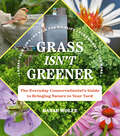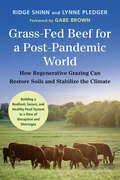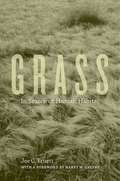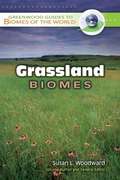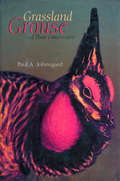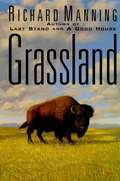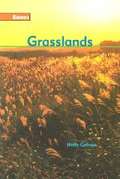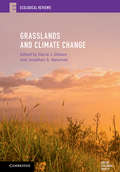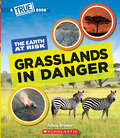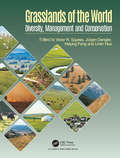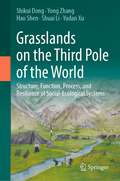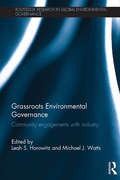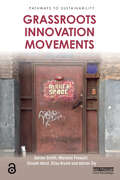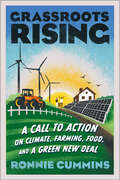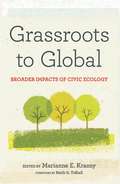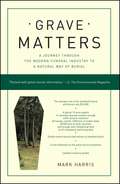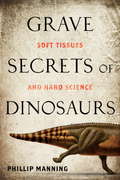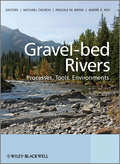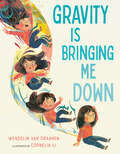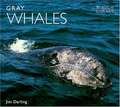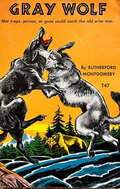- Table View
- List View
Grass Isn't Greener: The Everyday Conservationist's Guide to Bringing Nature to Your Yard
by Danae WolfeBuilt around easy-to-digest tips for improving sustainability, this fun, action-oriented guide will help everyone turn their home garden into an earth-friendly habitat. Rooted in twenty practical steps that anyone can take starting today, Grass Isn&’t Greener demonstrates how small changes in your yard or garden can create lasting impact for the planet: from leaving your leaves to selecting eco-friendly holiday decorations; from eliminating light pollution to attracting wildlife; from saving seeds to devoting even a small patch of lawn to native plants. With easy-to-follow advice and real-life examples, conservation educator Danae Wolfe will help you appreciate the new life you&’ve attracted to your yard. A companion for new homeowners, renters, and gardeners, Grass Isn't Greener is a resource for anyone looking for little ways to make a big difference—and to have fun doing it.
Grass-Fed Beef for a Post-Pandemic World: How Regenerative Grazing Can Restore Soils and Stabilize the Climate
by Ridge Shinn Lynne Pledger*With a foreword by Gabe Brown, bestselling author of Dirt to SoilHow can we learn from our mistakes and pave a way for sustainable, nutritious, local meat?The COVID-19 pandemic exposed the vulnerabilities of our globalized food system and highlighted the desperate need for local and regional supplies of healthy meat. We must replace corn-based feedlots, which are responsible for significant climate emissions, nitrogen pollution, and animal suffering. Grass-Fed Beef for a Post-Pandemic World outlines a hopeful path out of our broken food system via regional networks of regeneratively produced meat.In 2017, Ridge Shinn and Lynne Pledger went to market with Big Picture Beef, a company that partners with farmers across the Northeast to increase access to wholesale markets while promoting holistic grazing management techniques. The result? Increased health benefits for consumers, the environment, and livestock.In Grass Fed-Beef for a Post-Pandemic World, you&’ll find information assembled from the fields of ecology, climate science, nutrition, and animal welfare, along with on-the-farm stories from Ridge&’s travels as a consultant all over the United States and abroad.You&’ll discover how regenerative grazing can: restore degraded farmlandprotect against droughts and floodsincrease biodiversitycombat climate change by reducing emissions and sequestering carboncontribute to regional economic developmentproduce nutrient-dense, healthy meat for consumersGrass-Fed Beef for a Post-Pandemic World is not just for beef producers, but for anyone wondering how our farmers and ranchers can raise cattle while also caring for the local and global environment.&“The next time someone argues that cows are disastrous for the planet, hand them a copy of Grass-Fed Beef for a Post-Pandemic World. Equal parts manifesto and how-to guide, Shinn and Pledger will show you that the solution to our human and planetary health crisis begins with a cow eating grass and ends with the most delicious steak you&’ve ever had.&”—Dan Barber, author of The Third Plate
Grass: In Search of Human Habitat
by Joe C. TruettThe book explores the deep affinities between humans and our original habitat: grasslands. It traces the evolutionary, historical, and cultural forces that have reshaped North American rangelands over the past two centuries.
Grasshopper (Time-To-Discover)
by Melvin Berger Gilda BergerHow many eyes does a grasshopper have? What is a nymph? What do they eat?
Grassland Biomes (Greenwood Guides to Biomes of the World)
by Susan L. WoodwardRetired from teaching biogeography and physical geography, Woodward describes and compares the major grassland regions of the world. After reviewing the nature of grassland generally, she details each biome in temperate and tropical climates in terms of its climatic peculiarities, most prevalent soil types, characteristic structure of the vegetation, and typical plants and animals. Maps, photographs, and line drawing complement the text. Annotation ©2008 Book News, Inc., Portland, OR (booknews.com)
Grassland Grouse and Their Conservation
by Paul A. JohnsgardPaul Johnsgard, one of the world's leading ornithologists, has written this book as a call to action. Conservationists have seen a marked decline in the populations of North American grouse, particularly the grassland-adapted species. Unless action is taken swiftly, at least one species -- Attwater's prairie-chicken -- is certain to follow the heath hen into extinction. Johnsgard begins with the tragic history of the heath hen, which became extinct in 1932. He devotes a chapter each to the greater and lesser prairie-chickens, greater and Gunnison sage-grouse, and sharp-tailed grouse. Johnsgard argues that habitat loss and excessive hunting are major factors contributing to the decline of each species, particularly the lesser prairie-chicken and the Gunnison sage-grouse, which have been proposed for threatened federal status. This narrative history is troubling but not without hope. Johnsgard discusses places where populations exist that have yet to be preserved, and outlines the steps necessary to conserve these species. A possible future does exist for grassland grouse, and Johnsgard's book points the way toward securing it.
Grassland: The History, Biology, Politics, and Promise of the American Prairie
by Richard ManningThe author, an award-winning journalist and nature writer, looks at the grasslands of the American West and Midwest, tracing the region from pre-history to the present. He discusses attempts to control the land and efforts to restore native grasses and wild herds of buffalo, and visits Ted Turner's progressive and controversial Montana ranch. Annotation c. by Book News, Inc., Portland, Or.
Grasslands (Biomes)
by Holly CefreyThis book leads you into the Grasslands biome. It goes into detail of its many distinguishing features.
Grasslands and Climate Change (Ecological Reviews)
by David J. Gibson Jonathan A. NewmanGrasslands are the most extensive terrestrial biome on Earth and are critically important for forage, biodiversity, and ecosystem services. This book brings together an international team of researchers to review scientific knowledge of the effects of climate change on world grasslands, a process we are only just starting to understand. Part I assesses how climate change will impact on the distribution of grasslands, as well as production, biogeochemical cycling and ecosystem services. Part II considers the consequences for the spread of invasive species, demographic change, trophic-level relationships, soil biota, and evolutionary change within grassland biodiversity. Part III proposes how ecologists can respond to climate change effects, focusing on grazing systems, cultural ecology, range management, and restoration. The concluding chapter sets grasslands in the context of the Anthropocene era and identifies the vital research and conservation needs for grassland ecosystems to remain environmentally sustainable under climate change.
Grasslands in Danger (A True Book (Relaunch))
by Felicia BrowerDiscover the rich biodiversity of Earth's biomes - and how they might be saved - with this STEAM-based subset of True Books.Did you know that grasslands cover 25 percent of Earth's surface? They are also being destroyed at an alarming rate! Get ready to investigate tropical and temperate grasslands around the globe, as well as the plants and animals that have adapted to survive on them. You'll also learn about the many threats facing this fascinating biome-and what each of us can do to help-all in the pages of Grasslands in Danger.ABOUT THE SERIES:There are five major biomes on Earth: desert, forest, grassland, aquatic, and tundra. These rich, wild places are home to a wide variety of plants and animals - many of which are found nowhere else. Unfortunately, these ecosystems have been put at risk by human activities. This STEAM-based set of True Books introduces students to the incredible biodiversity of Earth's amazing biomes, as well as the threats they face in the era of climate change. Interesting information is presented in a fun, friendly way - and in the simplest terms possible - and will inspire kids to think about how they can help stop the destruction of Earth's wild spaces.
Grasslands of the World: Diversity, Management and Conservation
by Victor R. Squires Limin Hua Jürgen Dengler Haiying FengThis book begins with a brief account of the extraordinary sequence of events that led to emergence of grasslands as major vegetation formations that now occupy some of the driest and hottest and the highest and coldest on earth as well as vast steppes and prairies in more temperate climes. It is the story of grasses successfully competing with forests and woodlands, aided and abetted by grazing herbivores and by humans and their use of fire as a tool. It is a story of adaptation to changing climates and the changing biophysical environments. A major focus of the book is the Palaearctic biogeographic realm that extends over some 45 million km² and thus more than 1/3 of the terrestrial ice-free surface on Earth. It comprises extensive grasslands of different types and origin, which can be subdivided into (1) natural grasslands with (1a) steppes (climatogenic in dry climates), (1b) arctic-alpine grasslands (climatogenic in cold climates) and (1c) azonal and extrazonal grasslands (pedogenic and topogenic) as well as (2) secondary grasslands created and sustained by human activities, such as livestock grazing, mowing or burning. Grasslands of the Palaearctic do not only form a major basis for the agriculture of the region and thus its food supply, but are also crucial for other ecosystem services and host a supra proportional part of the realm’s plant and animal diversity. To reflect that suitability of grasslands for biodiversity strongly depends on their state, we apply the term High Nature Value grassland to those natural grasslands that are not degraded (in good state) and those secondary grasslands that are not intensified (semi-natural). The situation in a variety of countries where grasslands are evolving under the influence of global climate change is also considered. Case studies are presented on Southern Africa, Eastern Africa, India, China, South America, North America and Australia. The concluding chapter examines a set of themes arising from the chapters that make up the bulk of this book. The following provide a focus: recent history of grassland biomes – brief recap of current thinking and recent trends with special reference to dry grasslands in the Palearctic regions; the current status of grasslands and germplasm resources (biodiversity) – an overview; management systems that ensure sustainability; how to recover degraded grasslands; socio-economic issues and considerations in grassland management; the impacts of environmental problems in grasslands such as future climate change and intensification and the problems/prospects facing pastoralists and other grassland-based livestock producers.
Grasslands on the Third Pole of the World: Structure, Function, Process, and Resilience of Social-Ecological Systems
by Shikui Dong Yong Zhang Shuai Li Hao Shen Yudan XuThis book comprehensively covers the topics of origin and distribution, evolution and types, regional and global importance, biodiversity conservation, plant-soil interfaces, ecosystem functions and services, social-ecological systems, climate change adaptations, land degradation and restoration, grazing management and pastoral production, and sustainable future of the grasslands on the Qinghai-Tibetan Plateau (QTP), which is a globally unique eco-region called the "Roof of the World" because of its high elevation, “Third Pole on Earth" because of its alpine environment and the "Water Tower in Asia" because of its headwater location. The grassland ecosystem covers above 60% of QTP, which is about 2.5 million km2, 1/4 of Chinese total territorial lands. The grassland ecosystem of the QTP (the Third Pole) is an important part of the palaearctic region, which features alpine cover and low oxygen. The Third Pole's grasslands not only provide important ecosystem functions such as biodiversity conservation, carbon storage, water resource regulation, climate control, and natural disaster mitigation at a global scale, but also provide critical ecosystem services such as pastoral production, cultural inheritance, and tourism and recreation at local and regional scales. The purposes of this monograph are to address the following questions: (1) What are the special features of the Third Pole's grasslands? (2) How have climate changes and human activities changed the structures and functions of the Third Pole's grasslands? (3) How can we cope with land degradation and climate change through innovative restoration and protective actions for Third Pole's grasslands? And (4) How can we promote the sustainable development of social-ecological systems of the Third Pole's grasslands through best management practices including grazing? The goal of this book is to attract the attention of international audiences to realize the importance of the Third Pole’s grasslands, and to call for the actions of global communities to effectively protect and sustainably use the Third Pole's grasslands. This book can be served as textbooks, teaching materials and documentaries for different audiences. The target audiences include students, teachers, researchers, policy makers, planners, government officials, and NGOs in agricultural, environmental and natural resources sectors.
Grassroots Environmental Governance: Community engagements with industry (Routledge Research in Global Environmental Governance)
by Michael J. Watts Leah S. HorowitzGrassroots movements can pose serious challenges to both governments and corporations. However, grassroots actors possess a variety of motivations, and their visions of development may evolve in complex ways. Meanwhile, their relative powerlessness obliges them to forge an array of shifting alliances and to devise a range of adaptive strategies. Grassroots Environmental Governance presents a compilation of in-depth ethnographic case studies, based on original research. Each of the chapters focuses specifically on grassroots engagements with the agents of various forms of industrial development. The book is geographically diverse, including analyses of groups based in both the global North and South, and represents a range of disciplinary perspectives. This allows the collection to explore themes that cross-cut specific localities and disciplinary boundaries, and thus to generate important theoretical insights into the complexities of grassroots engagements with industry. This volume will be of great interest to scholars of environmental activism, environmental governance, and environmental studies in general.
Grassroots Innovation Movements (Pathways to Sustainability)
by Adrian Smith Mariano Fressoli Dinesh Abrol Elisa Arond Adrian ElyInnovation is increasingly invoked by policy elites and business leaders as vital for tackling global challenges like sustainable development. Often overlooked, however, is the fact that networks of community groups, activists, and researchers have been innovating grassroots solutions for social justice and environmental sustainability for decades. Unencumbered by disciplinary boundaries, policy silos, or institutional logics, these ‘grassroots innovation movements’ identify issues and questions neglected by formal science, technology and innovation organizations. Grassroots solutions arise in unconventional settings through unusual combinations of people, ideas and tools. This book examines six diverse grassroots innovation movements in India, South America and Europe, situating them in their particular dynamic historical contexts. Analysis explains why each movement frames innovation and development differently, resulting in a variety of strategies. The book explores the spaces where each of these movements have grown, or attempted to do so. It critically examines the pathways they have developed for grassroots innovation and the challenges and limitations confronting their approaches. With mounting pressure for social justice in an increasingly unequal world, policy makers are exploring how to foster more inclusive innovation. In this context grassroots experiences take on added significance. This book provides timely and relevant ideas, analysis and recommendations for activists, policy-makers, students and scholars interested in encounters between innovation, development and social movements.
Grassroots Rising: A Call to Action on Climate, Farming, Food, and a Green New Deal
by Ronnie Cummins&“This is a book that should be in the hands of every activist working on food and farming and climate change.&”—Vandana ShivaA practical, shovel-ready plan for anyone wondering what they can do to help address the global climate crisisGrassroots Rising is a passionate call to action for the global body politic, providing practical solutions for how to survive—and thrive—in catastrophic times. Author Ronnie Cummins, founder and director of the Organic Consumers Association, aims to educate and inspire citizens worldwide to organize and become active participants in preventing ecological collapse.This book offers a blueprint for building and supercharging a grassroots Regeneration Movement based on:• Consumer activism• Farmer innovation• Political change• Regenerative financeCummins asserts that the solution lies right beneath our feet and at the end of our forks through the transformation of our broken food system. Using regenerative agriculture practices that restore our agricultural and grazing lands, we can sequester massive amounts of carbon in the soil. Coupled with an aggressive transition toward renewables, he argues that we have the power to not only mitigate and slow down climate change, but actually reverse global warming by strengthening our infrastructure.Grassroots Rising shows that a properly organized and executed Regeneration Revolution can indeed offer realistic climate solutions while also meeting our everyday needs.&“This is a &‘good news&’ instructional book for Regeneration, a plan of action for the United States and the world to transition to climate stability, peace, justice, health, prosperity, cooperation, and participatory democracy.&”—Ronnie Cummins
Grassroots to Global: Broader Impacts of Civic Ecology
by David MaddoxAddressing participatory, transdisciplinary approaches to local stewardship of the environment, Grassroots to Global features scholars and stewards exploring the broad impacts of civic engagement with the environment.Chapters focus on questions that include: How might faith-based institutions in Chicago expand the work of church-community gardens? How do volunteer "nature cleaners" in Tehran attempt to change Iranian social norms? How does an international community in Baltimore engage local people in nature restoration while fostering social equity? How does a child in an impoverished coal mining region become a local and national leader in abandoned mine restoration? And can a loose coalition that transforms blighted areas in Indian cities into pocket parks become a social movement? From the findings of the authors’ diverse case studies, editor Marianne Krasny provides a way to help readers understand the greater implications of civic ecology practices through the lens of multiple disciplines.Contributors:Aniruddha Abhyankar, Martha Chaves, Louise Chawla, Dennis Chestnut, Nancy Chikaraishi, Zahra Golshani, Lance Gunderson, Keith E. Hedges, Robert E. Hughes, Rebecca Jordan, Karim-Aly Kassam, Laurel Kearns, Marianne E. Krasny, Veronica Kyle, David Maddox, Mila Kellen Marshall, Elizabeth Whiting Pierce, Rosalba Lopez Ramirez, Michael Sarbanes, Philip Silva, Traci Sooter, Erika S. Svendsen, Keith G. Tidball, Arjen E. J. Wals, Rebecca Salminen Witt, Jill Wrigley
Grave Matters
by Mark HarrisBy the time Nate Fisher was laid to rest in a woodland grave sans coffin in the final season of Six Feet Under, Americans all across the country were starting to look outside the box when death came calling. Grave Matters follows families who found in "green" burial a more natural, more economic, and ultimately more meaningful alternative to the tired and toxic send-off on offer at the local funeral parlor. Eschewing chemical embalming and fancy caskets, elaborate and costly funerals, they have embraced a range of natural options, new and old, that are redefining a better American way of death. Environmental journalist Mark Harris examines this new green burial underground, leading you into natural cemeteries and domestic graveyards, taking you aboard boats from which ashes and memorial "reef balls" are cast into the sea. He follows a family that conducts a home funeral, one that delivers a loved one to the crematory, and another that hires a carpenter to build a pine coffin. In the morbidly fascinating tradition of Stiff, Grave Matters details the embalming process and the environmental aftermath of the standard funeral. Harris also traces the history of burial in America, from frontier cemeteries to the billion-dollar business it is today, reporting on real families who opted for more simple, natural returns. For readers who want to follow the examples of these families and, literally, give back from the grave, appendices detail everything you need to know, from exact costs and laws to natural burial providers and their contact information.
Grave Secrets of Dinosaurs: Soft Tissues and Hard Science
by Phil ManningMany of us have seen dinosaur bones and skeletons, maybe even dinosaur eggs, but what did those fearsome animals really look like in the flesh? Soft-tissue fossils give tantalizing clues about the appearance and physiology of the ancient animals. Bone structure is just the beginning of our knowledge today, thanks to amazing digs like these. Drawing on new breakthroughs and cutting-edge techniques of analysis, Dr. Manning takes us on a thrilling, globe-spanning tour of dinosaur mummy finds from the first such excavation in 1908 to a baby dinosaur unearthed in 1980, from a dino with a heart in South Dakota to titanosaur embryos in Argentina. And he discusses his own groundbreaking analysis of Dakota, discovered by Tyler Lyson. Using state-of-the-art technology to scan and analyse this remarkable discovery, National Geographic and Dr. Manning create an incredibly lifelike portrait of Dakota. The knowledge to be gained from this exceedingly rare find, and those that came before it, will intrigue dinosaur-loving readers of all ages.
Grave's End: the brilliant third book in the DS Alexandra Cupidi investigations (DS Alexandra Cupidi #3)
by William Shaw'If you're not a fan yet, why not?' VAL MCDERMID'A superb storyteller' PETER MAYA BIZARRE DISCOVERYAn unidentified corpse is found in a freezer in the garage of an unoccupied house. DS Alexandra Cupidi is handed a case that is made even colder by no-one seeming to know or care whose body it is.A HISTORIC CRIMEIt becomes clear there is a connection between the crime and a skeleton uncovered underneath a housing development of Trevor Grey, a boy who went missing twenty five years earlier.A BURIED LIFEDigging deep into secrets that have long been concealed brings Cupidi to face a deadly conspiracy to hide these crimes. Her investigation is complicated by a secret liaison, a political cover-up and the underground life of Trevor Grey's only friend.With meticulously realised characters and a brooding setting, Grave's End confronts the crisis in housing, environmentalism, historic cases of abuse and the protection given to badgers by the law. The third book in the DS Alexandra Cupidi series confirms William Shaw as one of our finest writers of crime fiction.
Grave's End: the brilliant third book in the DS Alexandra Cupidi investigations (DS Alexandra Cupidi #3)
by William Shaw'If you're not a fan yet, why not?' VAL MCDERMID'A superb storyteller' PETER MAYA BIZARRE DISCOVERYAn unidentified cadaver is found in a freezer in an unoccupied luxury house. No-one seems to know or care who it is or who placed it there. When DS Alexandra Cupidi is handed the case, she can have no idea it will lead her to a series of murderous cover-ups and buried secrets. Namely the discovery of the skeleton of public-school boy, Trevor Wood, beneath a housing development.A HISTORIC CRIMEHis disappearance twenty five years earlier had almost passed unnoticed. But as evidence surfaces that his fate was linked to long suppressed rumours of sexual abuse, Cupidi, her teenage daughter Zoe and her friend Bill South find themselves up against powerful forces who will try to silence them. A BURIED LIFEDigging deep into the secrets that are held underground leads to Cupidi's realisation that crime and power are seldom far apart. There are dangerous connections between the two cases, which are complicated by Constable Jill Ferriter's dating habits, a secret liaison and the underground life of Trevor Grey's only friend.The most riveting and atmospheric DS Alexandra Cupidi novel so far, Grave's End confronts the crisis in housing, environmental politics, the protection given to badgers by the law. With meticulously mastered characters and a brooding setting, this third book in the series confirms William Shaw as one of the finest crime writers. (P)2020 Quercus Editions Limited
Gravel Bed Rivers
by Michael Church Pascale Biron Andre RoyGravel-Bed Rivers: Processes, Tools, Environments presents a definitive review of current knowledge of gravel-bed rivers, derived from the 7th International Gravel-bed Rivers Workshop, the 5-yearly meeting of the world's leading authorities in the field.Each chapter in the book has been specifically commissioned to represent areas in which recent progress has been made in the field. The topics covered also represent a coherent progression through the principal areas of the subject (hydraulics; sediment transport; river morphology; tools and methods; applications of science).Definitive review of the current knowledge of gravel-bed rivers Coverage of both fundamental and applied topics Edited by leading academics with contributions from key researchers Thoroughly edited for quality and consistency to provide coherent and logical progression through the principal areas of the subject.
Gravity Is Bringing Me Down
by Wendelin Van DraanenGravity becomes a very personal problem for a girl as she stumbles and tumbles through a long day. A hilarious look at a core science concept for any kid who has ever had a case of the clumsies!When Leda wakes up by falling out of bed, she knows that gravity is in a very bad mood. Again.Sure enough, she struggles with stumbles and bumbles at home, trips and blips on the bus, and bashes and crashes in the classroom. But a lesson on gravity helps her understand what&’s really going on. And after a visit to a science center, Leda's mood is lifted...just in time for her to tumble-- happily!--into bed.With a very funny text from award-winner Wendelin Van Draanen and bright, bouncy illustrations from Cornelia Lia, Gravity is Bringing Me Down makes it hilariously clear how this science concept impacts kids' lives every day.
Gray Whales (WorldLife Library)
by Jim DarlingGray whales are a shallow-water species that inhabit coastal waters and lagoons. Alone in their taxonomic species, they live closer to land, and to humans, than any other large whales--characteristics that have made them easy targets for whalers. Unique in appearance, and in some of their habits, they hold the dubious distinction of being the only whale species with two extinct populations. Although often considered a conservation success story, the Asian Pacific population is still endangered. Jim Darling has been watching and studying gray whales for more than twenty years. He describes their life history, distribution, and massive migratory range of some 5,000 miles--the largest of any mammal--and he examines the threats that these social coastal creatures face. (From the Book Jacket)
Gray Wolf
by Rutherford MontgomeryLast of the great gray wolves--fleet, savage Speed, iron-jawed killer of the high country. Too cunning for poison and traps, too swift for men and dogs, he eludes every hunter. Can one of his own breed be trained to challenge him? What will happen when the two mighty lobos--father and son--meet in deadly battle?
Grayson
by Lynne CoxGrayson is Lynne Cox's first book since Swimming to Antarctica ("Riveting"--Sports Illustrated; "Pitch-perfect"--Outside). In it she tells the story of a miraculous ocean encounter that happened to her when she was seventeen and in training for a big swim (she had already swum the English Channel, twice, and the Catalina Channel).It was the dark of early morning; Lynne was in 55-degree water as smooth as black ice, two hundred yards offshore, outside the wave break. She was swimming her last half-mile back to the pier before heading home for breakfast when she became aware that something was swimming with her. The ocean was charged with energy as if a squall was moving in; thousands of baby anchovy darted through the water like lit sparklers, trying to evade something larger. Whatever it was, it felt large enough to be a white shark coursing beneath her body.It wasn't a shark. It became clear that it was a baby gray whale--following alongside Lynne for a mile or so. Lynne had been swimming for more than an hour; she needed to get out of the water to rest, but she realized that if she did, the young calf would follow her onto shore and die from collapsed lungs.The baby whale--eighteen feet long!--was migrating on a three-month trek to its feeding grounds in the Bering Sea, an eight-thousand-mile journey. It would have to be carried on its mother's back for much of that distance, and was dependent on its mother's milk for food--baby whales drink up to fifty gallons of milk a day. If Lynne didn't find the mother whale, the baby would suffer from dehydration and starve to death.Something so enormous--the mother whale was fifty feet long--suddenly seemed very small in the vast Pacific Ocean. How could Lynne possibly find her?This is the story--part mystery, part magical tale--of what happened . . .From the Hardcover edition.
